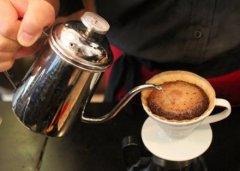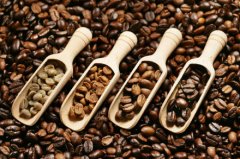Coffee and its products-terminology

National standard of the people's Republic of China
Terminology for coffee and its products
Coffee and its products-Vocabulary
GB/T 18007-1999
This standard specifies the most commonly used terms for coffee and its products.
This standard is applicable to the formulation and revision of relevant standards and documents, as well as the preparation and translation of professional manuals and teaching materials
And books and periodicals.
2 Coffee terms and definitions
2.1 General terminology
2.1.1 Coffee coffee
State Bureau of quality and Technical Supervision approved 2000-04-01 implementation on 1999-11-10 and 2000-04-01 on 1999-11-10 approval of State Bureau of quality and Technical Supervision.
The fruit and seed of a plant of the genus Coffea, consisting of a pericarp (exocarp, exocarp, etc.)
Mesocarp and endocarp), seed coat, seed kernels and embryos are processed to provide and eliminate costs.
2.1.2 small seed coffee Arabica coffee
Also known as Arabian coffee, the scientific name is Coffea arabica Linnaeus. This kind of coffee is very fruity.
Small, seed kernel is also small, so it is called small seed.
2.1.3 medium seed Coffee robusta coffee
Also known as Robasta coffee, the scientific name is Coffea canephora Pierre ex Froehner.
2.1.4 large seed Coffee liberica coffee
Also known as Liberian coffee, the scientific name is Coffea canephora Hiern. The fruit is better than other kinds of coffee.
The caffeine is big, so it is called big seed.
2.1.5 High Coffee excelsa coffee
Also known as Essex coffee, the scientific name is Coffea dewevre i De Wild et Durand
Var.excelsa Chevalier .
2.1.6 Alabasta Coffee arabusta coffee
It is a hybrid of small seed coffee and medium grain coffee, and its scientific name is Coffea arabica × Coffea.
Canephora Capot et Ake Assi .
2.1.7 unboiled coffee green coffee;;raw coffee
Coffee beans (2.2.11).
2.1.8 flat bean flat bean
Coffee beans with a conspicuously flat surface.
2.1.9 single bean pea bean;;caracol
An oval-shaped coffee bean developed from a single seed in a coffee fruit.
2.1.10 Elephant Bean elephant bean
A collection of coffee beans formed by pseudo-polyembryony. Usually consists of two coffee beans and sometimes a few coffee beans
A collection of brown beans.
2.1.11 diameter diameter
The diameter of the smallest round hole that a coffee bean can pass through.
2.1.12 Wet processing of coffee bean wet--processed coffee
Also known as wet coffee beans, that is, raw coffee made by wet processing.
2.1.13 mild coffee bean mild coffee
Specifically refers to the wet processing of small seeds of coffee.
2.1.14 dry processing of coffee bean dry--processed coffee
Also known as dried coffee beans, that is, the use of dry processing of raw coffee.
2.1.15 wash coffee beans washed and cleaned coffee
In the case of water, the dry method of removing silver skin from coffee beans is used to process coffee beans.
2.1.16 regain Coffee Bean monsooned coffee
Dry-processed coffee beans are exposed to wet weather so that they absorb water and swell, showing golden brown or light brown.
2.1.17 polished coffee beans polished coffee
The silver skin is removed by mechanical operation to make the coffee beans have a surging and good appearance of wet processing coffee beans.
2.1.18 sieve residual triage residue;;screenings
Screening and grading of defective coffee beans as well as foreign impurities and impurities from coffee fruits
Eg broken shell, etc.
2.1.19 roasted coffee roasted coffee
Raw coffee is obtained by roasting.
2.1.20 Coffee Powder ground coffee
The product of roasted coffee after being ground.
2.1.21 Coffee extract coffee extract
A product made from roasted coffee by physical method using water as a carrier. The rest of the residue is called coffee grounds.
2.1.22 Instant Coffee instant coffee
Using water as the carrier (water is the only substance that does not come from coffee) from roasted coffee by physical method.
A dried water-soluble product made from brown.
2.1.22.1 spray dried instant coffee spray--dried instant coffee
The liquid coffee extract is sprayed into hot air to evaporate water to form dry particles.
2.1.22.2 Secondary granulation coffee agglomerated instant coffee
Instant coffee prepared by agglomeration method, that is, the dry particles of instant coffee are fused to form larger particles.
2.1.22.3 freeze-dried coffee freeze--dried coffee
Instant coffee made by freezing liquid products and removing ice by sublimation.
2.1.23 decaffeinated coffee decaffeinated coffee
Coffee that has been caffeinated.
2.1.24 Coffee drink coffee brew
A beverage made by treating coffee powder or water with water into a coffee extract or instant coffee.
2.2 Coffee fruit
2.2.1 Coffee berry coffee cherry
The whole fresh fruit of the coffee tree.
2.2.2 Pulp pulp
The part of a caffeine berry that is removed during peeling, consisting of an exocarp and most of the mesocarp.
2.2.3 kinds of clothing parchment
That is, the endocarp of coffee fruit is a thin horny shell composed of stone cells.
2.2.4 dry clothes hull;;dried parchment
The dried endocarp of a currant.
2.2.5 Coffee beans with clothes bean in parchment;;parchment coffee
Coffee beans that are wholly or partially wrapped in a seed coat (endocarp). This is also raw coffee and roasted coffee.
A flaw in.
2.2.6 Coffee shell husk
The general term for the peel of dried coffee fruit.
2.2.7 dried fruit dried coffee cherry
Dried coffee fruit consisting of peel and coffee beans.
2.2.8 seed coat testa
It is a thin film covering the seed kernel, which is almost transparent.
2.2.9 Silver silverskin
The dried seed coat of coffee beans, usually silver or copper in appearance.
2.2.10 seed seed
It consists of seed coat, seed kernel and embryo.
2.2.11 Coffee bean coffee bean
The trade name of a dried coffee seed that has been stripped of silver skin.
3 defects in raw coffee and roasted coffee
3.1Shell crushed husk fragment
A fragment of a dried peel (coffee shell).
3.2 kinds of clothing piece piece of parchment
Fragments of a dried endocarp (seed coat).
3.3concave shell
A deformed coffee bean with a concave surface shaped like a shell.
3.4 chopped coffee beans bean fragment
Coffee bean fragments whose volume is less than half a coffee bean.
3.5 chopped beans broken bean
Coffee bean fragments with a volume equal to or half the size of a coffee bean.
3.6 aberrant bean malformed bean
Abnormal coffee beans can be clearly distinguished from normal coffee beans.
3.7 worm-eaten bean insect--damaged bean
Coffee beans eaten by insects on the inside or outside.
3.8 Insecticidal coffee bean insect--infested bean
3.8.1 Coffee bean live--insect infested bean with live worm
Coffee beans that hide one or more live worms at any stage of development.
3.8.2 Coffee bean dead--insect infested bean with dead insects
Coffee beans containing the remains of one or more dead insects or insects.
3.9 Black coffee bean black bean
More than half of the black beans on the outer or outer surface and interior of raw coffee; roasted
The rear shape is similar to coal lump, the color is dim, and the outer surface is usually granular.
3.10 semi-black bean partly black bean;;semi-black bean
Coffee having half or less black on the upper or outer surface and interior.
Beans. For roasted coffee, semi-black beans mean that less than half of the volume is in the shape of coal.
3.11 immature bean immature bean
Coffee beans obtained from unripe berries tend to wrinkle on the surface. Roasted coffee made from immature beans
The color of the coffee is lighter than the normal one.
3.12Sponge bean spongy bean
The firmness is similar to that of a cork, and the tissue can be pressed down into a dent, usually slightly whitish, with your fingernails.
Note: this is not a defect for regained coffee beans.
3.13Light Bean white low density bean;;floater bean
White, very light, its density is much lower than normal coffee beans.
Note: this is not a defect for regained coffee beans.
3.14 smelly coffee bean stinker bean
It smells bad on freshly cut incisions, and the coffee beans may be light brown or brown, and sometimes
Having a waxy appearance.
3.15 sour coffee bean sour bean
Coffee beans spoiled by overfermentation have a very light reddish-brown interior and can be roasted and drunk.
Produce a sour taste.
3.16 flowered pea blotchy bean
Coffee beans with irregular spots.
3.17 dried bean withered bean
Light wrinkled coffee beans.
3.18 mouldy bean of moldy bean
Coffee beans that are moldy or have mildew stains visible to the naked eye.
Important Notice :
前街咖啡 FrontStreet Coffee has moved to new addredd:
FrontStreet Coffee Address: 315,Donghua East Road,GuangZhou
Tel:020 38364473
- Prev

The attractive charisma of magic coffee
It is decided that the characteristic of ─ coffee is four flavors and one fragrance. All the color, aroma and taste of coffee are characterized by some chemical changes in raw coffee beans after baking. ◎ bitterness: caffeine, one of the basic flavor elements of coffee. ◎ sour taste: = = tannin acid, the second basic flavor element of coffee. ◎ concentrated alcohol: = = strong coffee. A mellow taste. ◎ sweet
- Next

Coffee and its products-- terminology (2)
Pulper--mipped bean cut or scraped wet processed coffee beans, often with brown black scars. 3.20 Brown coffee beans brown bean brown-black coffee beans. 3.21 White coffee beans white bean are simply called white beans, that is, coffee beans with a white surface. 3.22 Amber beans amber bean yellow coffee beans
Related
- Beginners will see the "Coffee pull flower" guide!
- What is the difference between ice blog purified milk and ordinary milk coffee?
- Why is the Philippines the largest producer of crops in Liberia?
- For coffee extraction, should the fine powder be retained?
- How does extracted espresso fill pressed powder? How much strength does it take to press the powder?
- How to make jasmine cold extract coffee? Is the jasmine + latte good?
- Will this little toy really make the coffee taste better? How does Lily Drip affect coffee extraction?
- Will the action of slapping the filter cup also affect coffee extraction?
- What's the difference between powder-to-water ratio and powder-to-liquid ratio?
- What is the Ethiopian local species? What does it have to do with Heirloom native species?

